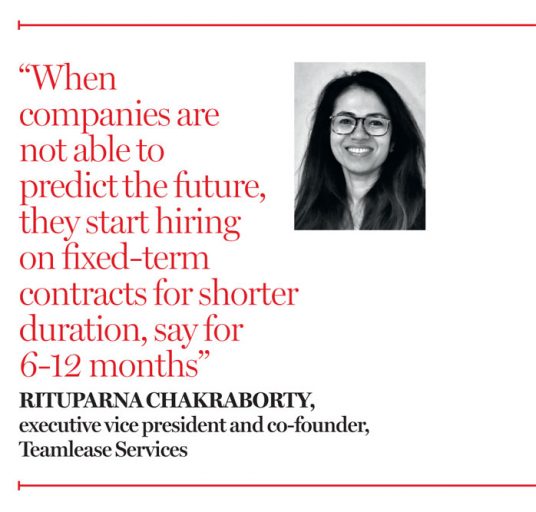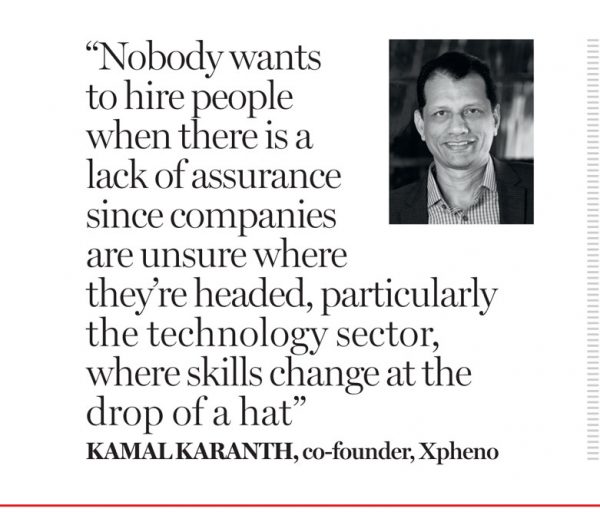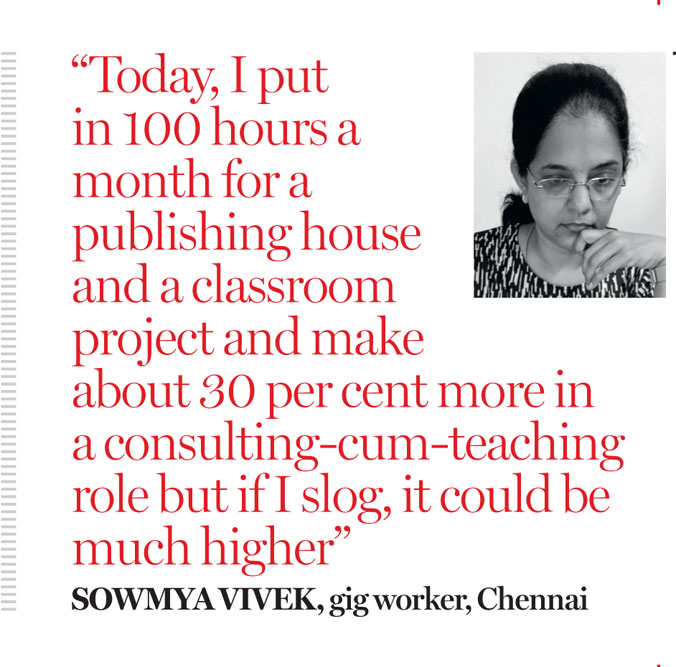Gig Jobs: The Slump Card
The dawn of white-collar gig jobs in a slowdown
 Moinak Mitra
Moinak Mitra
 Moinak Mitra
Moinak Mitra
 |
06 Sep, 2019
|
06 Sep, 2019
/wp-content/uploads/2019/09/Gigjobs1.jpg)
(Illustration: Saurabh Singh)
AS FEARS OF the ongoing downturn being more structural than cyclical surface with the GDP growing a mere 5 per cent in the June 2019 quarter, the slowest rate in six years, the job market in India has hit rock bottom. Big-ticket employers, such as the automobile industry, consumer goods, textiles and IT, are in layoff mode. According to a report by Azim Premji University, 5 million Indians lost their jobs between 2016 and 2018. In 2018 alone, the International Labor Organisation claimed that 18.6 million Indians were jobless, and this year, that number is inching towards 18.9 million. Against this backdrop, gigging is fast becoming a way of life. The gig economy is characterised by short-term relationships between the employer and employee and once the project is completed, the gig worker is free to move on. A McKinsey report highlights that nearly 20-30 per cent of the developed world’s workforce is independent labour.
Short-duration, project-driven and outcome-oriented work is also getting its due in India and that defines the new-age, high-mobility gig economy that fuels Uber and Ola drivers or Swiggy and Zomato delivery folks at the very low end, to data scientists, market analytics specialists and CXOs at the top of the pyramid. Though reliability of data in the world of gig jobs is still a concern, 70 per cent of the corporates surveyed by a human resources consultancy, Noble House, said they had used gig workers at least once for major organisational issues in 2018.
In many ways, it is the Uberisation of the top and middle of the workforce that keeps the stove burning today for the great Indian middle class and beyond. In 2018-2019, nearly 72 per cent of all gig projects were in large corporates and professional services firms compared to 52 per cent two years ago, claims the Professional Gig Economy Report Card, a study carried out by Flexing It, a curated marketplace for consultants and on-demand expertise.
For Chandrika Pasricha, founder and CEO of Flexing It, the demand for senior and top management gig workers is a year-round phenomenon. “If the company is trying to hire a CFO, it will take at least six months. This is when it approaches us for a stop-gap CFO who can take on the mantle for, say, three months. Another frequent use case is the consultant driving initiatives end-to-end, such as strategic advisory, new business launches and devising the growth strategy,” explains Pasricha, adding that companies are now turning to independent talent owing to cost flexibility. “For a full-time worker, you need to pay salary for the entire year plus benefits and space costs whereas a gig worker may be used only for the time you need them, which may come at half the cost [of a full-time employee]. So if you’re sure that a role does not require 100 per cent utilisation, it vastly improves efficiencies,” she says.

On the Flexing It platform, Pasricha’s logic has spawned some 80,000-odd on-demand consultants at the moment, driving short-term projects of 3,374 clients spanning corporates, consulting firms and startups. A bulk of them possesses more than 10 years of experience and could be from across industries and functions. Though Pasricha is tightlipped on the addition to her temporary workforce due to layoffs resulting from the slowdown, she admits that her gig workers make a conscious choice. “People want to do more impactful work and choosing their clients and projects gives them hope of controlling their impact. Besides, they have a desire for flexibility as they don’t want to struggle from 9 to 9. It makes them the master of their own time,” she elaborates. Typically, gig projects range from a few days’ engagement to six months and may even extend depending on the nature of such gigs.
Consider Chhavi Mishra, 39, a talent acquisition and HR specialist with more than 11 years of experience. Having started out in IT and manufacturing, Mishra’s been at gig jobs for over a year now after her e-commerce education startup Yoscholar.com got acquired. Already at her second stint as an independent worker, Mishra earned her stripes with a leading consulting firm earlier, hiring 400 sales professionals for a top manufacturing company when it was launching a “unique” product in the market. That was a six-month engagement and afforded her multiple roles within the consultancy. The Bengaluru-based Mishra is now helping place learners on an e-learning platform, a startup. Initially, it was a two-month contract and is getting extended indefinitely. But Mishra is not complaining. She may not get the benefits and perks as a full-time employee would, but four hours of work a day doesn’t cost much. “I can take on other projects, maybe two more, and make my time count and perhaps even make more than a regular employee would, but right now, I have bandwidth issues and value my time,” she says matter-of-factly.
WHILE MISHRA may have made a conscious choice to stay out of the rat race, there is no doubt that a steady stream of out-of-jobbers is making the most of such moonlighting opportunities, including top management workforce. Ask Kamal Karanth, the Bengaluru-based co-founder of specialist staffing firm Xpheno, and he will tell you that a downturn is always inversely proportional to the buoyancy witnessed in temporary hiring, more so in the upper echelons of the corporate ladder. “This is because nobody wants to hire people when there is a lack of assurance since companies are unsure where they’re headed, particularly the technology sector, where skills change at the drop of a hat. Also, typically, about 30 per cent of the folks who get hired are not the right fit and temporary workers fill in for the crying need of such talent within such organisations,” says Karanth.

Karanth’s firm helped place a CFO in a funded startup in the June quarter for Rs 3 lakh a month at a time when the startup wanted to raise money from the market. The candidate in question was laid off from a large IT shared services firm where he made about Rs 5-6 lakh a month. When his three months with the startup was over, he was hired by a much larger startup at his previous pay. He got lucky, unlike a swathe of top-dollar CXOs in the country—as many as 58 MDs and CEOs of NSE-listed companies quit in the first seven months of this year. Although one short of last year over the same period, it was otherwise the highest in the past 14 years. Blame it on the stress across sectors, zero tolerance for underperformance and increased scrutiny on ethics by the company boards. To hazard a guess, maybe a few of them have taken to gig jobs by now.
Ram Raja, who goes by his LinkedIn profile as a ‘resonance marketer’, is not one of them although he’s been a CMO-grade gig artist for over two-and-a-half years. Independently, Raja consults for specific requirements in marketing and focuses on early-to-mid-stage brands that are looking for resonance with early customers to get traction to the next level. Having worked in major ad agencies and media companies, both in India and abroad, Raja sew up his own startup, Innr.me, from scratch. It was a global wellness coaching platform that connected people with some of the top wellness coaches from the world over. Even when the startup went bust, Raja’s entrepreneurial bug did not die. “The startup gave me a process of understanding where the gaps were. When the funding was drying up, it took me three months to gather myself. But what I realised was that there is a unique opportunity to bring my marketing acumen to early-stage companies who need top-level, world-class, mature marketing hands for a certain period,” he elaborates. Today, Raja takes on two-three projects a year, typically of four-six months’ duration. He works outside the company locations and meets clients whenever needed. The last assignment he worked on was for a luxury women’s retreat in Bali, and a few weeks from now he’s jetting off to New York to serve another client’s need as its ‘gig’ CMO.
Most action in the world of premium gig jobs though pivot round the middle and senior end of the spectrum. However, purists like Rituparna Chakraborty, Executive Vice President and co-founder of Teamlease Services, would like to draw a distinction between gig jobs and temporary staffing claiming gigs to be nothing more than commoditised services, like the ubiquitous Uber or Ola driver who works on a commission basis with the ride hailing service. However, “the law of the land doesn’t differentiate between a temporary worker [and a full-timer] when it comes to benefits and wages… under the structure of fixed-term contracts, all associates [consultants] are by law entitled to whatever a permanent worker gets,” she says. But Chakraborty’s lone voice at Teamlease, which tosses up 220,000 temporary workers across industries today, drowns in a sea of gig workers elsewhere who are denied such benefits. Both Chhavi Mishra and Ram Raja would testify to that. “I’m paid on a par with regular employees if you take into account the cash-in-hand minus the benefits,” says Mishra.

But Chakraborty too sees demand for temporary staffing spiking during a recession. “When companies are not able to predict the future, they start hiring on fixed-term contracts for shorter duration, say for 6-12 months, and when the economy starts looking up, the good ones can always be moved to the company’s rolls,” she says. According to her, certain jobs, of course, remain recession-proof, such as in the chameleon-like technology domain. For instance, Chakraborty claims that a candidate with four-five years of experience on Hadoop (an open-source solution that allows several computers to solve problems jointly) will today command Rs 4-5 lakh a month, irrespective of market dynamics. “We are seeing a lot of demand for newer technologies and salaries can range from Rs 10 lakh to Rs 1 crore a year depending on the function.”
This is where the 46-year-old Chennai-based independent consultant Sowmya Vivek has cashed in as well. With her experience in publishing for over 25 years, she moved to Daily Hunt, a publishing startup, in 2015.
Here, she was at liberty to work half the month from home and specialised in statistics and analytics. Gradually, she started building her profile as it gave her enough time to enrol for a one-year course in analytics on online training platform Great Learning. On getting her degree the following year, Vivek became an independent consultant and took up varied projects from NGOs to other publishing houses with analytics as her new calling card. Alongside, she provides classroom training for Great Learning. Today, she puts in 100 hours a month for a publishing house along with the classroom project and is making more than she would in a traditional job. “I’m making about 30 per cent more in a consulting-cum-teaching role and if I slog, it could be much higher,” she admits.
The gig economy may still be a far cry in India from what it is abroad, as the country first has to sort out the distinction between formal and informal workforce by law, but there are enough takers for gig jobs at varying income levels. Likewise, gig platforms are springing up to address every need. While Better Place connects blue-collar workers with companies, Frapp, Avigna and Upwork enable students to earn a quick buck by completing projects for large corporates. Flexing It, Tap Chief and Noble House, meanwhile, match high-end jobs with skilled white-collar professionals.
Last year, when Better Place conducted a survey with 1.1 million respondents to determine the age of gig workers in India, the 24-38 age group stood out at 64 per cent with the low-end, blue-collar workforce making up the bulk of it. However small their share in the pie, white-collar jobs, too, are getting gigged. And with the unemployment rate at a high 6.1 per cent in 2017-2018 (5.3 per cent in rural and 7.8 per cent in urban), at least for now, the gig jobs are here to stay.

/wp-content/uploads/2025/09/Cover-Modi-scaled.jpg)










More Columns
I Missed A Flight Thanks To Robert Redford, Plus He Took My Magazine! Alan Moore
Robert Redford (1936-2025): Hollywood's Golden Boy Kaveree Bamzai
Surya and Co. keep Pakistan at arm’s length in Dubai Rajeev Deshpande